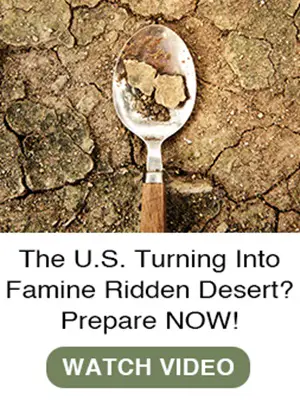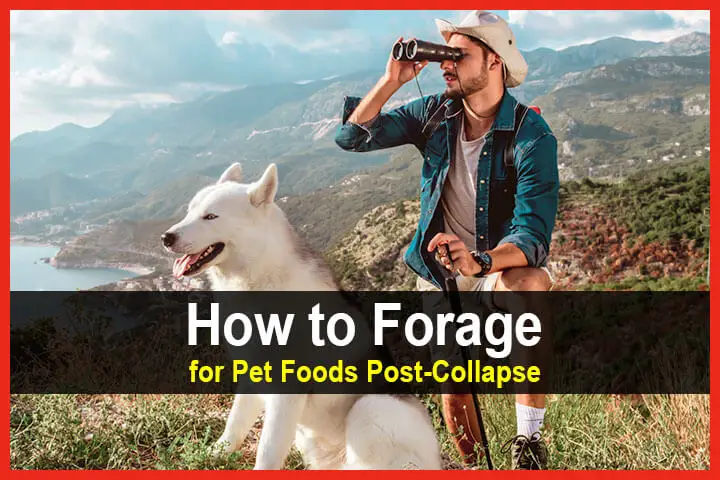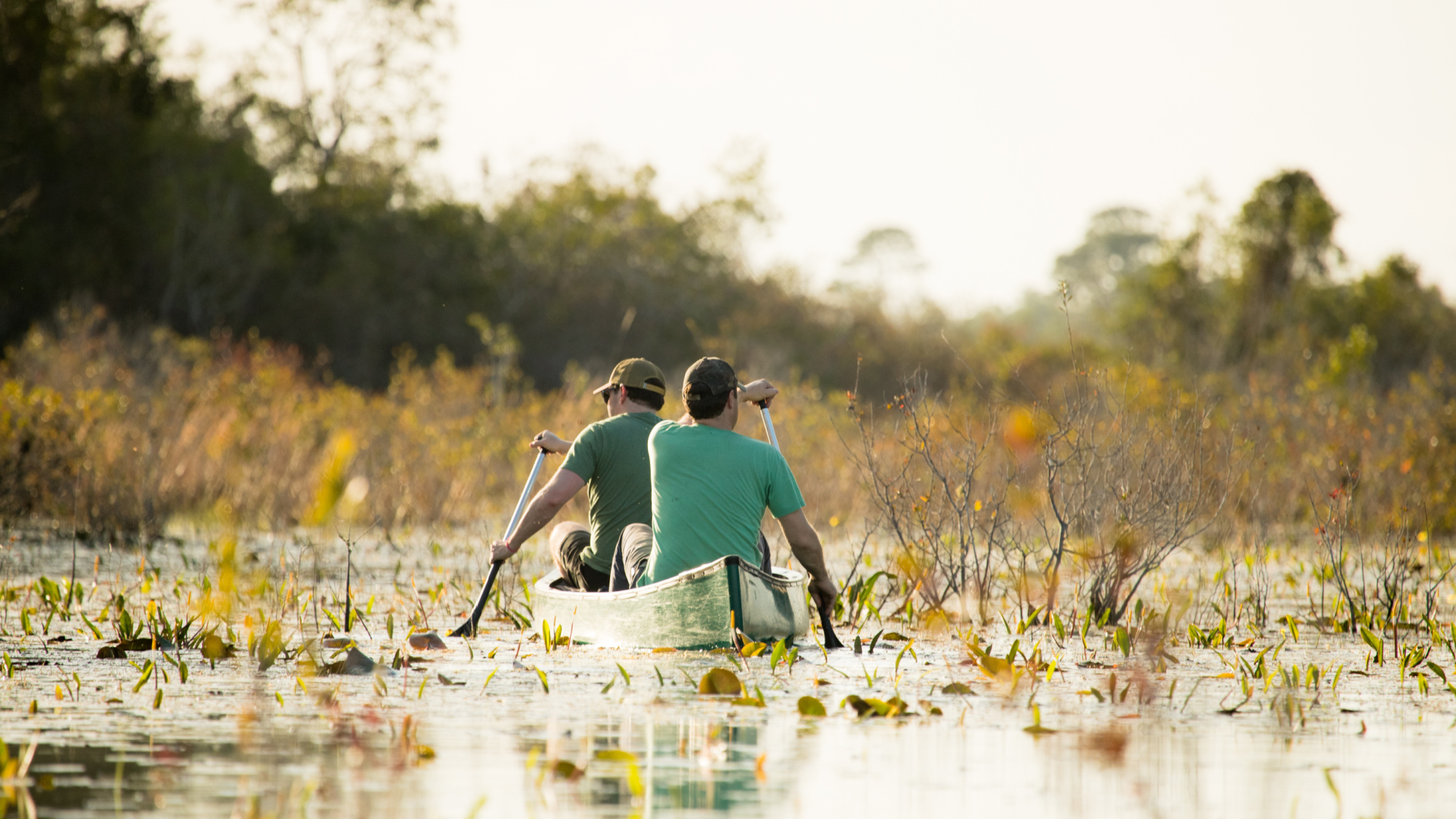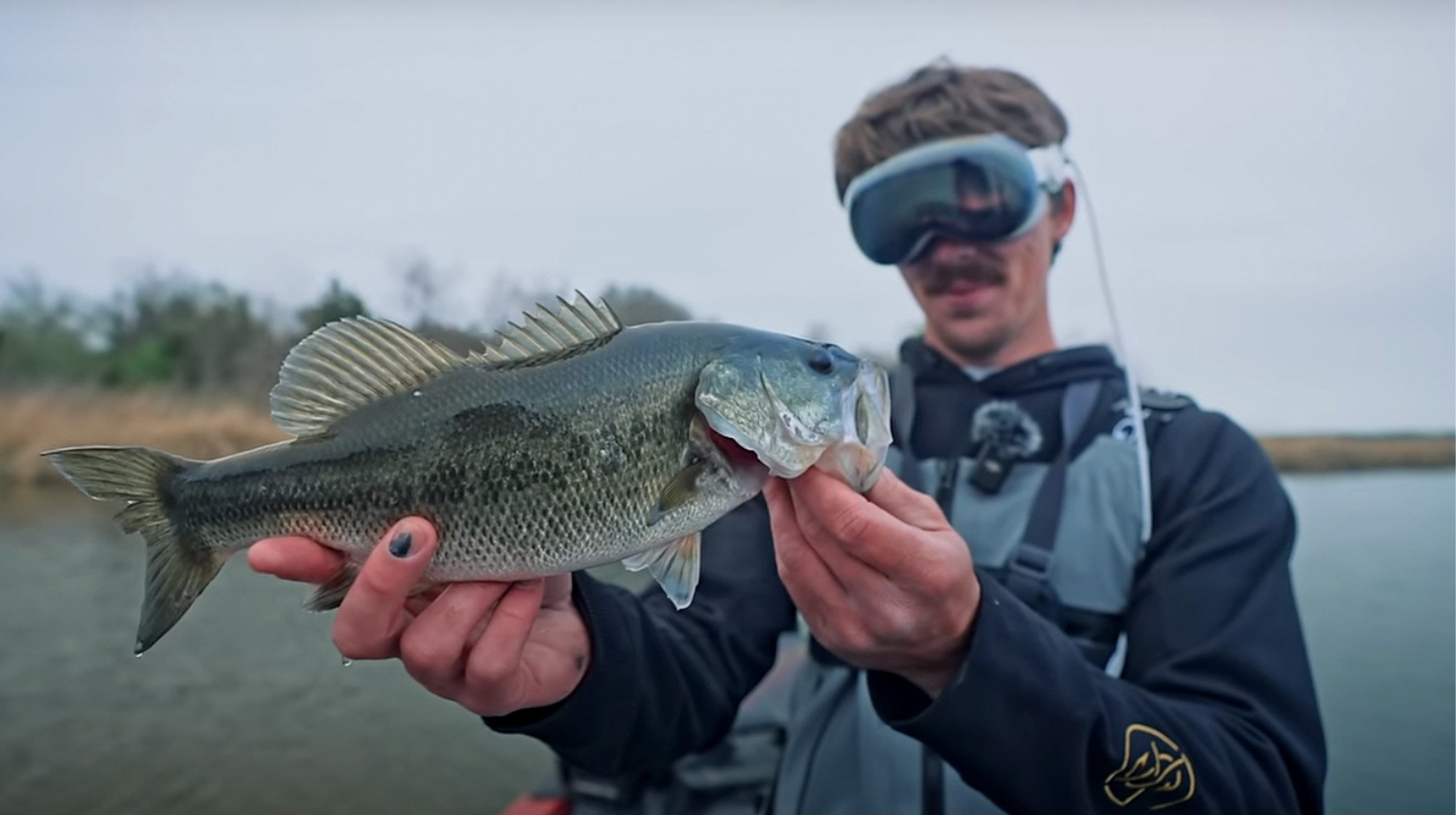Estimated reading time: 21 minutes
After a societal collapse it’s no surprise that there are shortages of everything. Stores are closed, the supply chain no longer exists and stockpiles everywhere are running short. It’s at times like that when people turn to hunting, fishing, farming and foraging to find food. Many people are successful but while our priority is often about feeding our families we sometimes don’t think about our pets.
The range of animals that we’ve domesticated as family pets is long and varied. Dogs and cats are the most common, but birds aren’t far behind in addition to a number of kid’s pets from turtles to frogs, hamsters, gerbils, rabbits, chameleons and even snakes and more than a few aquarium fish.
In the meantime we’ve become accustomed to an occasional trip to the pet store to stock up on a large bag of dog or cat food, or toss a few bags of birdseed or hamster food in the cart. It often lasts for weeks if not a month or more, but what happens when it runs out and is simply unavailable.
Want to save this post for later? Click Here to Pin It On Pinterest!
Some Obvious Solutions

A lot of us go out of our way not to feed table scraps to our dogs and cats. After a collapse all bets are off and table scraps may be our first solution when it comes to feeding some of our pets. But even then, many pets have unique dietary needs that may not be satisfied by table scraps in the long-term.
Complicating things a bit is that pets like birds, amphibians, and rodents like hamsters and gerbils aren’t always satisfied or sustained by most table scraps. That’s when wild foraging can offer some simple and easy solutions.
The Wild Foraging Instinct

This isn’t about send your pets off into the wilderness to fend for themselves, but they could do it quite well if they had to. It’s all a matter of DNA and evolution. Dogs are descended from wolves, cats evolved from Mountain Lions, Panthers and Tigers, and as for birds –their ancestors were something called dinosaurs.
If ever there was a genetic disposition for wild forging it comes from all of those distant ancestors.
In fact, a dog or cat on a leash, or free-running in safe environments, can surprise you with their ability to locate edible wild animals and plants. Dogs are still constant companions during some hunting trips, and more than a few cats have done double duty around the house and businesses tracking down mice.
Then again, you can’t assume they can always find their own food -leashed or not. But that creates a bit of a dilemma for us. It’s largely true that pets have a good instinct about what to eat and what not to eat. Unfortunately they’re at a disadvantage when we start mixing up and blending foraged foods and toss it into their bowls or dish. It’s important to know what they should or shouldn’t eat and try to minimize the quantity of any one wild foraged food to some degree.
As we explore further we’ll see how something as basic as dandelion greens can make for a good wild foraged food supplement for dogs and cats. However, dandelion greens are also high in oxalates and too much can put a heavy burden on their kidneys.
Worse, many wild foraged foods are toxic if not poisonous. Given the relatively lower body weight of most pets, even a toxic plant that would only make us nauseous could be deadly to a dog or cat. We’ll cover the good and bad as we go, but if in doubt –either do some more research or skip it.
Pets We’ll Cover
We’re going to stick with the most popular pets and try to isolate what you can forage for them. And foraging will include both plants and animals. That squirrel you may be hesitant about eating would make a feast for a dog or cat, and the same goes for that carp you weren’t sure about. Unless of course that squirrel happens to be your pet.
Here’s the pet list:
- Dogs
- Cats
- Birds – parakeets, canaries, parrots
- Amphibians- Turtles, snakes, frogs
- Aquarium fish
Wild Foraging with Your Pet

Before we get into the ins and outs of wild foraging, taking your pet with you can offer a lot of benefits for both you and the best friend. Obviously you would only do this with a dog or cat, but they may give you some clues about what they want to eat on a regular basis.
It’s also good exercise for your pet and you; creates a stronger bond, good mental stimulation for your pet and the ultimate benefit of natural nutrition. Be mindful of what they gnaw on or find but get used to them being constantly distracted by just about everything else around them.
Carnivore, Herbivore or Omnivore?

Pet diets vary. Dogs are omnivores eating both animals and plants. Curiously, cats are mostly carnivores eating mostly other animals, and birds tend to be herbivores focused on seeds and plants although some are quite partial to insects from time to time. What you need to do is understand their feeding tendencies and make sure you provide them with a diet consistent with their natural instincts and needs.
It’s also important to introduce any wild foraged foods into their diet slowly and in small quantities. We mentioned the oxalates in dandelions but there’ more to it than that. Wild animals engage in a constant cycle of feeding and foraging throughout the day.

We tend to feed our pets in large quantities at the same time 2 or 3 times a day. That’s not how their wild counterparts are used to eating, and probably explains why so many dogs spend so much time at our feet when we’re chopping something in the kitchen.
If you’re moving to a wild foraged diet for your pets you may need to change your feeding style to a more wild approach. Think about feeding them 4 to 6 times a day in smaller quantities with a blend of what you’re hunted or foraged.
That blended approach is how many dog food processors combine ingredients in their pet foods. The only difference is you’re giving them the added nutrition and benefit of freshly foraged foods on a feeding cycle that they instinctively prefer.
Fresh, Frozen or Dried?

Fresh is not always best. Cooking can release more nutrients and make it easier for your pet to eat. Then again, fresh, raw and uncooked is how they are used to find foods in nature. The only exception is wild animals. If you hunt down a rabbit, squirrel or other animal in the wild to feed your pets it’s often good to cook it first to kill any microbes or parasites that may be in the meat. The same is true for fish and shellfish.
The reason you have to consider various preservation techniques has to do with seasonality. Many of these wild foods and even domesticated garden vegetables mature at certain times of the year, and most aren’t around in winter. Think about drying or freezing some of the pet foods you forage.
Frozen vegetables and fruits are a good option. Dogs seem to enjoy the chewy crunch of frozen vegetables and fruits. Better yet, freezing will allow you to preserve many foods you forage. Drying also works and any dried leafy vegetables, greens or fruits can be added into their feeding bowls later.
It Doesn’t Have to be Wild
You can easily plant many of the foods that are recommended for pets or share garden harvest with them. Specialized plants that produce seeds favored by pet birds, turtles or dogs can be easily grown in your yard or the surrounding area to give you a good supply of pet food over the seasons. Better yet, planting your own ensures you’ll always be giving your pets plants that are safe to eat.
Wild Foraged Plants that are Pet Safe

A general rule with any wild foraged or garden foraged plant is to introduce them into their foraged diet slowly in small quantities until they are used to the addition. Limit some plants high in oxalates like dandelion greens, spinach and kale. You want to see how well they tolerate it in terms of digestion. If you notice diarrhea it may be something you foraged for them.
Ideally, you offer them a blend of harvested foods. You could add meat or fish to a dog or cat’s dish in addition to certain wild foraged plants. Here are some wild plants often identified as pet food sources:
- Burdock Root
- Calendula
- Chamomile
- Chickweed
- Chicory
- Dandelion Greens
- Dock
- Duckweed
- Echinacea
- Fiddle Head Ferns
- Lambs Quarters
- Lavender
- Purslane
- Seaweed and Algae
- Thyme
Some Dog Digressions

Dogs confound us sometimes when it comes to what they’ll eat. It’s not uncommon to see a dog chewing on tall grasses and some seem to be particularly partial to rotten fruit.
Puppies will even eat the feces of other animals like rabbit and deer. That’s probably best discouraged although there are some arguments that animal feces have beneficial bacteria. It seems it would have harmful bacteria as well so it’s not a behavior most people would encourage.
Here are some other unique things on a dog’s wild menu that are safe for a dog to eat. Some may be growing in your backyard.
- Rotten Fruit
- Fresh Berries – Blueberries, strawberries, Blackberries, Mulberries
- Grasses (Let the dog tell you. They will often munch on grasses but they instinctively know which are safe to eat)
- Cucumbers and Watermelon and all other squash varieties
- Celery and Asparagus
- Pumpkin and Banana
- Legumes like some beans and peas. Green beans in any quantity
- Avocado
- Leafy Greens like lettuce, spinach, chard, cabbage, and kale
- Root Vegetables like carrots, beets, sweet potatoes and parsnips
- Broccoli, Brussels sprouts, cauliflower, and corn.
Wild Things to Keep Pets Away From
- Roadkill (Another bad idea because you don’t know how long that carcass has been rotting on the side of the road)
- Feces (Just say no)
- Avoid toxic berries like Holly Berries, Juniper Berries, Baneberries, Poke Berries and Mistletoe Berries, Yew Berries, Honeysuckle Berries
Plants to Avoid
It’s one thing to prevent your pet from eating something you suspect may be harmful, it’s another if we unintentionally forage a plant that can harm or kill our pet.
A common caution for anyone who does any wild foraging is to be 100% sure of what your are foraging and eating. The simple fact is that most plants are toxic and many are absolutely poisonous. The reason is simple.
Plants can’t run away from predators so they have evolved defenses over millions of years. Some develop thorns or needles. Other develop chemicals that irritate the skin. Most develop a toxic mix of chemicals that will make any animal sick or even kill it.
Don’t assume that a pet has some magic instinct that will stop them from eating something that’s toxic or deadly. This is especially true when you mix it into a bowl with other foods that mask any scents or clues of a toxic plant.
Here are some common wild plants that are deadly or toxic to most animals including us.
- Giant Hogweed
- Hemlock
- Grains (for dogs)
- Deadly and Bitter Nightshade berries
- All members of the Allium family including onions, garlic, leeks, chives and shallots. Toxic to pets from diarrhea to organ failure.
- Mushrooms (96% of wild mushrooms in North America are toxic or deadly)
Animals That Dogs and Cats Hunt in the Wild

It’s probably not the best idea to let your pets free roam for food, but it’s worth noting what they would hunt if they had the chance. This is true for both dogs and cats and snakes as well.
- Mice
- Voles
- Rabbits
- Birds
- Snakes and small lizards
- Large insects
- Fish and Shellfish (cats)
Birds – Parakeets, Canaries, Parrots

When it comes to pets, birds rank third behind dogs and cats. Parakeets are the most popular followed by canaries and parrots. For many people, the idea of wild foraging foods for birds is the most challenging. Pet birds eat predominantly seeds that are easily purchased by the bag at pet stores.
When the pet stores are closed or the seed is unavailable it can be challenge for many to find alternative. Fortunately, seeds abound in the wild but here again you have to know what to forage, or what to plant in and around your yard. Planting things like millet or amaranth for their seeds may actually be a very good idea and they grow easily.
Birds also like insects and worms but chop them and they are best served dead or you’ll have bugs in the house when the birds miss them.
It’s also important to remember that most birds can and will eat a range of foods beyond seeds. This would include insects, green leafy vegetables and in the case of parrots, nuts and fruits. Here’s a fairly long list of the types of foods that pet birds can safely eat:
Parakeets:

Seeds
- Millet
- Sunflower seeds
- Safflower seeds
- Chia seeds
- Clover seeds
- Dill seeds
- Fennel seeds
- Fenugreek seeds
- Mustard seeds
- Radish seeds
- Sprouted seeds
- Flax seeds
- Poppy seeds
- Sesame seeds
Nuts

Nuts are a favorite with parrots but even parakeets and canaries will nibble on nuts if they are shelled. Make sure they are unsalted and in the case of acorns they should be soaked in changes of water for 3 days to remove tannins. These nuts align with the general rule that if it’s safe for us to eat, it most likely is safe for our pets.
- Acorns
- Black Walnuts
- Hazelnuts
- Peanuts
- Pistachio
- Walnuts
- Pecans
Legumes

This goes back to dogs and cats and even some rodents like rabbits, hamsters and gerbils. But there’s a big caution. Some legumes are toxic to animals, especially small animals like birds and gerbils. Stick with this list and make them part of a meal if possible, although dogs will wolf down a bowl of peas without hesitation.
Here are the legumes that are safe for pets to eat and preferably served to the pet cooked and/or frozen.
- Black eye peas
- Chickpeas
- Green peas
- Lentils
- Mung beans
- Yellow peas
- Adzuki beans
Fruits

Fruits are another type of wild foraged and gardened food that can supplement a pet’s diets. Birds are especially fond of berries with large seeds like blackberries, both dogs and cats seem to think of any frozen berry as the ultimate dessert.
Here again, serve in moderation and ideally mixed in with other foods. Too much fruit at one time can lead to diarrhea. Add to their dish fresh or frozen. Larger fruits should be chopped into bite size pieces.
- Apples/Crab Apples
- Bananas
- Coconut
- Melon
- Blackberries
- Blueberries
- Raspberries
- Watermelon
- Pineapple
Vegetables

This goes beyond the realm of wild foraging a bit, but if you have a vegetable garden you also have a pet food garden. Vegetables are good for most pets although cats can be a bit finicky so see what works. Serve chopped either fresh or frozen.
Birds particularly like the leafy greens of any vegetable so don’t lose those carrot tops, celery leaves or any other leafy parts of these vegetables.
- Bok Choy
- Broccoli Stems
- Cabbage
- Carrots
- Celery
- Green lettuce
- Spinach
Grains

Here’s the telegram: whole grains can be an excellent addition to a pet’s menu but don’t feed grain to dogs. Dogs can’t digest grains and they can actually be toxic. However, Whole grains are a favorite for birds, rabbits, and other small rodents like gerbils, hamsters and mice. Here are some of the grains to consider while foraging or for local plantings.
- Buckwheat
- Barley
- Oats
- Rye
- Quinoa
- Amaranth
- Wheat
- Wild Grass seed like rye grass (Avoid Cockspur, Barnyard Millet, Japanese Millet)
Flowers

The flowers of many plants are edible but once again, some are highly toxic. Foxglove and poppies can be deadly. Follow the standard advice – if it’s safe for you to eat it should be safe for your pet.
The benefit or adding flowers to a pets diet has to do with the scarcity of fruits and seeds in the spring. The petals are usually the only part of the flower added to a pet’s dish. Flowers are usually in full bloom at that time and can at least add a supplement to a sparse pet menu in the spring.
Here are flowers often identified as safe for pets:
- African Violets
- Carnations
- Daisies
- Magnolias
- Marigold
- Petunias
- Roses
- Sunflowers
Additional Wild Foraged Pet Foods to Avoid

Wild foraging is never easy and there are certain plants and parts of plants you don’t want to give to your pets. A lot has to do with their low body weight. We can tolerate many of these foods but when you have a bird weighing a few ounces or a dog or cat weighing 15 to 30 pounds the chemical compounds in some plants are too highly concentrated for their metabolism.
Here are some plants to simply avoid.
- Alliums (Onions, garlic, chives, leeks)
- Avocados
- Wild Mushrooms (They’re just not worth the risk)
- Tomatoes
- Peppers
- Fruit seeds (Many fruit seeds contain traces of cyanide)
- Fruit pits (More cyanide)
Amphibians – Turtles, Frogs, Snakes

Amphibians are often a favorite pet for kids. Turtles, chameleons, and frogs top the list any some people have a snake in a terrarium. Foraging food for amphibians may be the easiest task of any type of pet although snakes can make things a little complicated. Here’s a book on raising snakes that covers their diet including small, live rodents like mice.
For the most part, amphibians prefer a diet of insects, worms and in the case of turtles, leafy vegetables in addition to worms and slugs. Crickets are a favorite of frogs but any crawling insect won’t last long in a terrarium with a frog.
Here’s the list as a recap. It’s typically wise to avoid flying insects because once again many of them might find their way into your house.
- Leafy Greens
- Worms
- Slugs
- Crawling insects
Aquarium fish

Aquariums are common in many homes. They actually serve as humidifiers in winter when indoor air can become extremely dry. The fish food always seems so easy as we sprinkle some crumbs of food on the surface and watch the fish eat. But when there’s none to buy you’ll need natural alternatives.
Insects are a go-to source of aquarium fish food. Larger insects can be cut up or crushed to create bite sized pieces. You could also harvest aquatic insects including the larvae of many insects. Just be careful with things like mosquito larvae. If the fish don’t eat it the mosquitoes will emerge from the water and populate your home.
Aquarium fish also like algae. Sometimes it grows in a tank whether you want it or not. You should also consider real plants in your tank. Many fish will nibble on the vegetation. If you come across wild plants growing in water consider adding them to your tank.
One other thing… Kitchen Scraps
Some of us are pretty good about getting those kitchen scraps into a compost heap. Before you head to the heap, think about which vegetable trimmings could go into your pets dish whether it’s some chopped cabbage or broccoli for the dog or cat, or a leaf of lettuce stuck into your bird’s cage.
Points to Ponder
When wild foraging always be mindful of locations that might be polluted by insecticides, fertilizers, herbicides or even natural pollutants from septic systems or sewers. The idea is to keep your pets healthy not make them sick.
It’s also wise to do some additional research. Wild foraging is complex and always remember that while you may be able to tolerate many plants you forage, the smaller body weights of many pets can be easily overwhelmed by something you easily tolerate.
And don’t forget that any hunting, fishing or animal husbandry can not only provide you with a source of protein, but food for your pets as well.
Here are some good links to books, articles and videos that explore the concept of wild foraging for pets and wild foraging in general.
Articles:
Videos:
Books:
Like this post? Don’t Forget to Pin It On Pinterest!

Read the full article here




